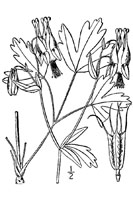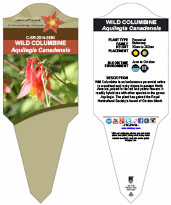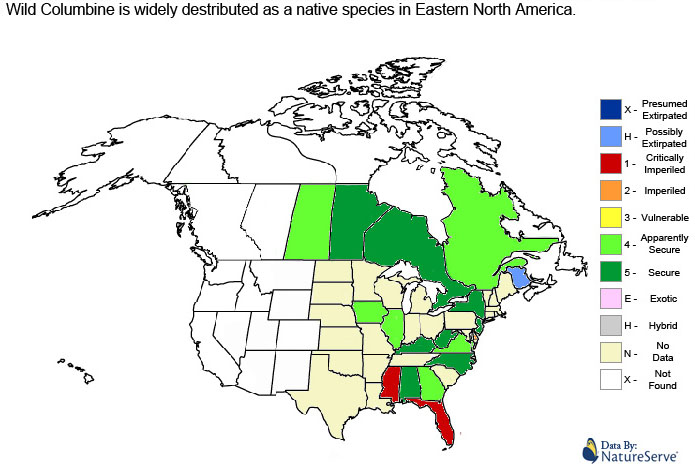Wild Columbine is an herbaceous perennial native to woodland and rocky slopes in eastern North America, prized for its red and yellow flowers. It readily hybridizes with other species in the genus Aquilegia. The plant has gained the Royal Horticultural Society's Award of Garden Merrit. The genus name may have been derived from the latin word aquila, "eagle," a possible reference to the spurs. The species name means "of Canada."
There is currently no commercial applications for wild columbine.
Within the realm of rational and holistic medicine, Native American tribes used various parts of red columbine in herbal remedies for ailments such as headache, sore throat, fever, rash caused by poison ivy, stomatitis, kidney and urinary problems, and heart problems. Native American men also rubbed crushed seeds on their hands as a love charm.
Please note that MIROFOSS does not suggest in any way that plants should be used in place of proper medical and psychological care. This information is provided here as a reference only.
The flowers of the wild columbine plant are said to be sweet and rich in nectar; which make them a very attractive addition to mixed salads and can also be used as a thirst-quenching munch in the garden. There have been reports of the roots being chewed for their medicinal virtues. Caution should be advised based on the plants toxicity.
Wild Columbine is a deciduous perennial which grows 30cm to 200cm tall. Wild Columbine has basal leaves which grow 7cm to 30cm long, 10cm to 15cm wide. Each individual leaflet is compound and have three lobes. The flowers are 3cm to 5cm long with five red petals. Each flower contains five sepals and numerous stamens. Wild Columbine fruit is follicle, 15mm to 30mm long in clusters of five. Wild Columbine prefers to grow in Rocky, wooded or open slopes and sometimes in swamps. Shaded or open woods, often around cliffs, rock outcrops, and forest edge, sometimes in swamps, from sea level to 1600 metres.
| Plant Height |
30cm to 200cm |
| Habitat |
Rocky wooded, or open, slopes |
| Leaves |
Trifoliate |
| Leaf Margin |
Crenate |
| Leaf Venation |
Cross-venulate |
| Stems |
Finely hairy |
| Flowering Season |
April to July |
| Flower Type |
Radially Symmetrical |
| Flower Colour |
Red |
| Pollination |
Insects |
| Flower Gender |
Flowers are hermaphrodite and the plants are self-fertile |
| Fruit |
Follicle Fruit |
| USDA Zone |
3B (-34°C to -37°C) cold weather limit |
The following health hazards should be noted when handling or choosing a location to plant wild columbine:
 |
TOXIC
Wild Columbine contains a cyanogenic glycoside, which releases poisonous hydrogen cyanide when the plant is damaged.
|
 |
-Click here- or on the thumbnail image to see an artist rendering, from The United States Department of Agriculture, of wild columbine. (This image will open in a new browser tab) |
 |
-Click here-or on the thumbnail image to see a magnified view, from The University of Texas, of the seeds created by wild columbine for propagation. (This image will open in a new browser tab) |
Wild Columbine can be referenced in certain current and historical texts under the following four names:
Wild Columbine can be translated into the following select languages: |
| Arabic |
كولومبين البرية |
Bulgarian |
Див колумбин |
Chinese (Sim) |
野菜哥伦比亚 |
| Croatian |
Divlji kolumbin |
Czech |
Divoká kolumbie |
Danish |
|
| Dutch |
|
Esperanto |
|
Estonian |
wild kurekell |
| Finnish |
|
French |
|
German |
|
| Greek |
Άγρια κολομπίνα |
Hebrew |
קולומבין פראי |
Hungarian |
Vad kolumbine |
| Italian |
|
Japanese |
野生のコルンビン |
Korean |
야생 비둘기 |
| Punjabi |
ਜੰਗਲੀ ਕਲਮਬਿਨ |
Lithuanian |
|
Norwegian |
|
| Persian |
کلمباین وحشی |
Polish |
Dzikiej kolumbiny |
Portuguese |
|
| Romanian |
|
Russian |
Дикий кулумбин |
Slovak |
Divoký kolumbín |
| Spanish |
|
Swedish |
|
Tagalog |
ligaw na kalapati |
| Turkish |
|
Ukrainian |
дикий водозбір |
Vietnamese |
|
The information provided in this conservation assessment has been provided by the Natureserve Database in conjunction with various federal, provincial, state, county, district, regional, and municipal governments as well as public and private conservation authorities. Information in this section is accurate from the last time this article was updated.
|
 |
Wild Columbine is considered to be a secure native species in North America. |
 |
The MIROFOSS database offers free printable garden tags for personal and non-profit use. These tags can be used to properly identify plant samples in a garden. Click on the tags shown on the the screen or -click here- to download a full size jpeg image for a wild columbine identification tag; which can be printed on paper or used with a plastic laser printer. |
 |
What's this?
This is a QR code (short for Quick Response) which gives fast-track access to MIROFOSS articles. QR Codes are barcodes that can be read by smart phone cameras. This QR Code is unique to this MIROFOSS article.
What can I do with it?
You can copy and print the QR code to a plant label, poster, book, web site, magazines, or newspaper so smart phone users can scan the QR Code which automatically takes them to this specific article. |
| Description |
Kartesz, J.T. 1994. A synonymized checklist of the vascular flora of the United States, Canada, and Greenland. 2nd edition. 2 vols. Timber Press, Portland, OR. |
| Folklore |
MacKinnon, Kershaw, Arnason, Owen, Karst, Hamersley, Chambers, (2009) Edible and Medicinal Plants of Canada.
ISBN 978-1-55105-572-5 |
| Biology |
Dickinson, T.; Metsger, D.; Bull, J.; & Dickinson, R. (2004) ROM Field Guide to Wildflowers of Ontario. Toronto:Royal Ontario Museum, |
| Image Rendering |
USDA-NRCS PLANTS Database / USDA NRCS. Wetland flora: Field office illustrated guide to plant species. USDA Natural Resources Conservation Service. |
| Environment |
National Audubon Society. Field Guide To Wildflowers (Eastern Region): Alfred A. Knopf. ISBN 0-375-40232-2 |
| Physical Identification |
National Audubon Society. Field Guide To Wildflowers (Eastern Region): Alfred A. Knopf. ISBN 0-375-40232-2 |
| May 05, 2017 |
The last time this page was updated |
| ©2021 MIROFOSS™ Foundation |
|

























